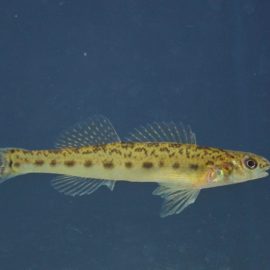
U.S. Fish and Wildlife Service
The Pearl River Darter is no longer in the Pearl River.
The Pearl River darter may not be returning to its namesake river anytime soon, but the endangered fish now has a fighting chance in nearby waterways. Last week, the federal government protected 524 miles of river in 13 Mississippi counties that make up the Pearl and Pascagoula River basins, capping decades of lawsuits and lobbying by environmental groups. “Dams and pollution have hammered these tiny fish, but they’re still clinging to survival in these key rivers,” said Will Harlan of the Center for Biological Diversity, a group that sued the U.S. Fish and Wildlife Service in 2021 for what it called the agency’s failure to designate critical habitat for the bottom-dwelling fish years after the agency added it to the list of protected wildlife under the Endangered Species Act (ESA).
nola.com
Now any federally funded project will have to jump another hoop to protect these fish.
The newly protected areas require any federally funded or permitted project to consult with Fish and Wildlife to make sure the darter’s habitat isn’t harmed. Efforts to reintroduce and recover several darter populations could be spurred by the new protections, Harlan said. Measuring less than three inches long, the snub-nosed darter typically hides among river bottom rocks to pounce on insects and tiny crustaceans. Found only in the fresh waters of east Louisiana and Mississippi, its already-limited range has shrunk by about half in recent decades. It’s been about 50 years since the darter was last spotted in the 444-mile-long Pearl, which starts in central Mississippi and runs past St. Tammany and Washington parishes, forming Louisiana’s eastern border. The Ross Barnett Reservoir near Jackson, Mississippi and small dams leading into the West Pearl Navigation Waterway are the main causes of the darter’s disappearance from the Pearl, according to researchers at Tulane University. The reservoir and dams block fish migration to upstream spawning areas. The darter has also been harmed by pollution from pulp and paper mills, oil and gas operations, and farms. The fish is now confined to a few scattered locations in Mississippi’s Pascagoula River Basin, where it faces threats from in-stream gravel mining and dams. “Once it’s gone from the Pascagoula, that’ll be the demise of the species,” Tulane darter researcher Hank Bart said in 2021.

U.S. Fish and Wildlife Service
The One Lake project is now being looked at again.
It’s unclear how the new ESA protections might affect a proposed Pearl River flood control project near Jackson, known as “One Lake.” The project has already stirred up controversy over its possible environmental impacts in St. Tammany and other downriver areas. The U.S. Army Corps of Engineers announced late last year that it would spend $221 million on river widening for One Lake as long as the project meets environmental criteria. The darter was first placed on the endangered species waiting list in 1991. In 2004, the center petitioned for the darter’s protection, and in 2010 filed a lawsuit over delays. The fish was listed as threatened under the ESA in 2017 but habitat protections were delayed, triggering another lawsuit from the center. Two other threatened species – the Gulf sturgeon and ringed map turtle – occupy the darter’s habitat and may also benefit from the new protections. The South is a “global hotspot of aquatic biodiversity,” according to the center. About 60% of the nation’s fish species live in the South’s rivers “Southern rivers are the most biologically diverse in the temperate world,” Harlan said. “By protecting the river habitat of (the darter), we’re creating a healthier future for humans, too.”

